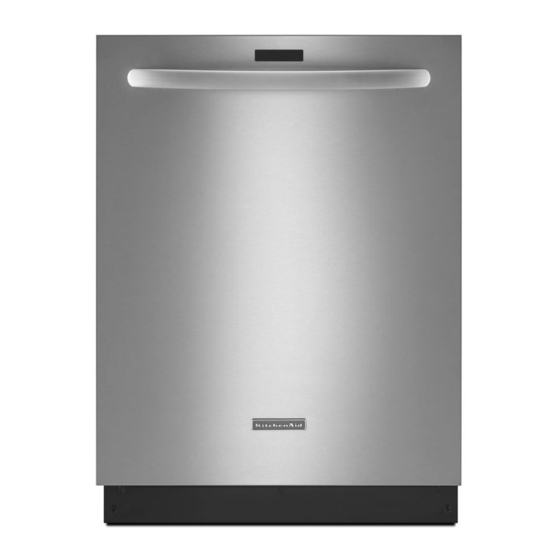KitchenAid KDTE554CSS Руководство пользователя - Страница 3
Просмотреть онлайн или скачать pdf Руководство пользователя для Посудомоечная машина KitchenAid KDTE554CSS. KitchenAid KDTE554CSS 17 страниц.

1.
Prepare and Load the Dishwasher
10 place load - upper rack
12 place load - upper rack
IMPORTANT: Remove leftover food, bones, toothpicks and other hard
items from dishes. Remove labels from containers before washing.
Make sure when dishwasher door is closed no items are blocking
detergent dispenser.
Items should be loaded with soiled surfaces facing down and
inward to the spray as shown in the graphics above. This will
improve cleaning and drying results. Angle dirtiest dish surface
downward, allowing space for water to flow up through rack and
between dishes.
Avoid overlapping items like bowls or plates that may trap food.
Place plastics, small plates and glasses in upper rack.
Wash only items marked "dishwasher safe."
To avoid thumping/clattering noises during operation: Load dishes
so they do not touch one another. Make sure lightweight load items
are secured in racks.
When loading silverware, always place sharp items pointing down
and avoid "nesting" as shown. If your silverware does not fit into the
designated slots, flip covers up and mix silverware types to keep
them separated.
Use slots in the covers and suggested
loading patterns to keep your
silverware separated for optimum
wash. (See illustration, right.)
2.
Check that all arms spin freely
OPERATING YOUR DISHWASHER
10 place load - lower rack
12 place load - lower rack
3.
Add Detergent
NOTE: If you do not plan to run a wash cycle soon, run a rinse cycle.
Do not use detergent.
Use automatic dishwasher detergent only. Add detergent just
before starting a cycle.
Fresh automatic dishwasher
detergent results in better
cleaning. Store tightly closed
detergent container in a cool, dry
place.
Premeasured Detergents
Many detergents now come in
premeasured forms (gel packs,
tablets, or powder packs). These
forms are suitable for all hardness and soil levels. Always place
premeasured detergents in main compartment and close lid.
Using dishwasher detergent tablets and packs have been proven better
than powder, liquid or gel detergents at reducing filming on dishes.
Using tablets and packs over time will start to reduce or eliminate white
film. Also, by using a rinse aid you can minimize repeat buildup of white
film.
4.
Add Rinse Aid
Your dishwasher is designed to use rinse aid for good drying
performance. Without rinse aid, your dishes and dishwasher interior
will have excessive moisture. The heat dry option will not perform
as well without rinse aid.
Rinse aid keeps water from forming droplets that can
dry as spots or streaks. It also improves drying by
allowing water to drain off of dishes after final rinse.
To add rinse aid, turn the
dispenser cap to "Refill" and
lift off. Pour rinse aid into the
opening until indicator level is
at "Full." Replace dispenser
cap and turn to "Lock." Make
sure cap is fully locked.
NOTE: For most water conditions,
the factory setting will give good
results.
Check water hardness level to ensure no rings
or spots on your dishware before adding rinse
aid or adjusting the factory setting.
If you are experiencing poor drying
performance, you may want to try a higher
setting.
Turn the arrow adjuster inside the dispenser to change rinse aid setting.
5.
Select a Cycle (cycles vary by model)
Efficient dishwashers run longer to save water and energy, just as
driving a car slower saves on gas. Typical cycle time is approximately
2¹⁄₂ hours, but can take less or more time to complete depending on
selections.
3
Full
Add
